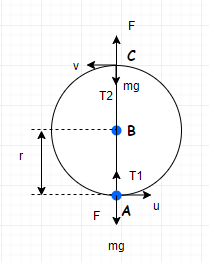Question
Question: A small ball of mass \[2\times {{10}^{-3}}kg~\] having a charge of \[1\mu C\] is suspended by a stri...
A small ball of mass 2×10−3kg having a charge of 1μC is suspended by a string of length 0.8 m. Another identical ball having the same charge is kept at the point of suspension. Determine the minimum horizontal velocity which should be imparted to the lower ball so that it can make a complete revolution.
Solution
We have to diagrammatically represent the given situation. Further, we have to analyse the mechanical and the electrostatic forces that act on the balls. Since it is suspended by a string, tension and gravitational force will exist and due to the presence of charge, electromagnetic force may also exist.
Formula Used:
Electrostatic force between two charged bodies q1, q2 separated at a distance r.
F=rkq2, where k is a constant.
Centripetal force F of a body with mass m and velocity v rotating in radius r
F=rmv2
Complete step by step answer:

There are two balls in this circle created. The ball at the centre B and the ball at A
The ball at A experiences gravitational force downwards, and electrostatic force with the ball at the centre, in the upward direction. It also experiences tension T1.
Gravitational force F=mg
Electrostatic force =rkq2
We can take the topmost point C as the critical point, where all the resultant forces act towards the centre. Here, the tension is zero.
We can say that the resultant at critical point is the centripetal force.
Hence,
⇒rmv2=mg+T2−rkq2
Since T2 is zero,
\begin{aligned}
& \dfrac{m{{v}^{2}}}{r}=mg-\dfrac{k{{q}^{2}}}{r} \\\
& \Rightarrow {{v}^{2}}=gr-\dfrac{k{{q}^{2}}}{mr}\\_\\_\\_\\_\\_\\_\\_\\_\\_\\_\\_(1) \\\
& \\\
\end{aligned}
When we take A as the reference point and apply law of conservation of energy,
